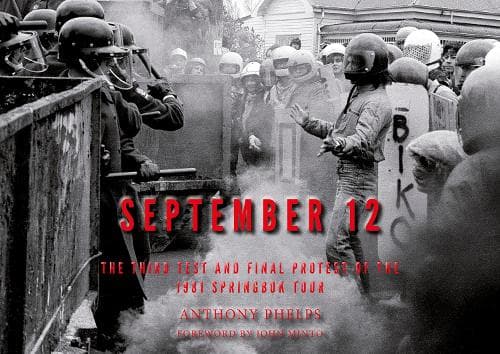Review: September 12 – The third test and final protest of the 1981 Springbok Tour
Reviewed by Michael Burgess
At first glance, the photo captures a typical day out at the rugby in the 1980s as fans mingle in the sun outside Eden Park before a game. That’s until you notice the long barbed wire barricade, stretched the length of the car park, just metres from where those fans are sitting.
Another image captures supporters heading down Sandringham Road, on their way to the stadium, with tickets in hands and smiles on their faces, while a thin blue line of baton wielding police hold off massed ranks of protestors clad in motorcycle helmets.
This was the jarring juxtaposition of July and August 1981, when the presence of the South African rugby team created divisions in this country on a scale that’s hard to imagine, even decades on.
Families and communities were split and some prominent All Blacks, including the incumbent captain Graham Mourie decided not to play against the Springboks.
Prime Minister Robert Muldoon refused to use his influence to stop the tour (as Norman Kirk had done in 1973) and the New Zealand Rugby Union was determined to press on. So, the tour went ahead amidst a groundswell of protest; across 56 days, there were an estimated 150,000 people involved in 200 demonstrations across 28 towns and cities, with 1500 people charged.
It culminated on the last day of the tour, notorious for the flour bombs dropped from a Cessna plane and the violent street clashes outside Eden Park.
That final day of protest is this focus of the book by Anthony Phelps, who was a wide-eyed teenager working in his first photography job. It was a seminal moment for Phelps, sparking a lifelong passion for news photography, though he admits he has never covered an event like that anywhere in the world.
Photo: Anthony Phelps
The images are raw and confronting, chaotic and challenging, gripping and gritty. Kiwis are characterised as a placid, law-abiding people but this was civil disobedience on a level rarely seen, epitomised by one shot of thousands of protesters marching down a quiet suburban street, heading for a confrontation with police.
“It was a determined battle for the soul of this country,” writes John Minto in the foreword, arguing that it was the closest New Zealand came to civil war since the land wars of the 1800s.
The book covers the build-up, with pro-tour marches down Queen Street and a stop the tour protest through Symonds Street, while Phelps was also at Auckland Airport as protestors tried to storm the tarmac when the South African team disembarked, but it’s mostly centred about the events of September 12.
Even knowing the context, the images are surreal.
Hundreds of jumbo rubbish bins lining Sandringham Road as police prepare the barricades; the Biko Battalion (named in honour of the anti-apartheid activist Steve Biko, who died in police custody in South Africa in 1977) on the march with crude, full body shields fashioned from plywood; curious residents watching on from nearby houses as batons crack against helmets; a group of protesting clowns, assembled to bring some levity to the protest, some of whom were later severely injured by the feared elite Red Squad, which sparked an internal police investigation and eventually a successful civil trial brought against the police department.
Phelps was at the frontline, admitting he was fortunate not to be injured, as the drama happened around him and expertly captured the tension, anger and violence of an unprecedented confrontation.
The photos have been well curated, though some more written information or context would have been ideal in places, to complement the superb pictures. Overall though, it’s an important study of a polemic and divisive episode in New Zealand history and a valuable addition to the library of works on the topic. It presents images that will - and should – never be forgotten, even if the elements of the Rugby Union and the New Zealand Police wish they were.
Reviewed by Michael Burgess
